|
|
|
Sort Order |
|
|
|
Items / Page
|
|
|
|
|
|
|
| Srl | Item |
| 1 |
ID:
153895


|
|
|
|
|
| Summary/Abstract |
The Brazilian-Argentine Agency for Accounting and Control of Nuclear Materials (ABACC) is a unique bilateral nonproliferation regime created by Brazil and Argentina after a long process of negotiations and confidence building. The creation of the agency in July 1991 marked a paradigmatic shift in the Brazilian-Argentine relationship, converting their long rivalry into a profound strategic partnership. This article presents a historical overview of the creation of ABACC and discusses how it paved the way for the integration of Brazil and Argentina into the nonproliferation regime. The article also shows how ABACC tackled nonproliferation challenges in the twenty-first century, helping Brazil and Argentina continue their nuclear programs with fewer risks to the autonomy and development goals traditionally defended in their foreign policies.
|
|
|
|
|
|
|
|
|
|
|
|
|
|
|
|
| 2 |
ID:
160990


|
|
|
|
|
| Summary/Abstract |
With the continued use of unsafeguarded naval nuclear-propulsion programs in all nuclear-weapon states, the commissioning of an Indian nuclear submarine, and the potential investment in such programs by non-nuclear-weapon states including Brazil and South Korea, movement toward a regulatory regime for nuclear material in the naval sector has become imperative. Such a framework faces a recurring debate on adequately protecting sensitive military technology while delivering assurances that naval nuclear material is not diverted to nuclear-weapon programs. In this viewpoint, we examine various prospective mechanisms to regulate naval nuclear stocks and assess them in terms of their effectiveness and scope. Drawing on lessons from the drafting, negotiation, and implementation of the Model Additional Protocol, we recommend a safeguards regime for naval nuclear material via a protocol that supplements the existing global nuclear-governance system. This protocol provides a standardized yet flexible approach to naval nuclear-material safeguards across all states (whether nuclear-weapon states, non-nuclear-weapon states, or outside the Treaty on the Non-Proliferation of Nuclear Weapons) to handle variations among naval nuclear fuel cycles and technologies.
|
|
|
|
|
|
|
|
|
|
|
|
|
|
|
|
| 3 |
ID:
142649
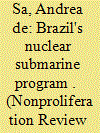

|
|
|
|
|
| Summary/Abstract |
Narratives about Brazil's nuclear program are distorted by supporters and critics alike. In Brazil, the national nuclear infrastructure is undergoing a period of expansion, with plans to build new nuclear power plants and industrial-scale fuel production facilities. While Brazil's leaders herald the nuclear sector as a triumph for indigenous science and technology, foreigners view the nuclear program as a dangerous legacy of the military regime. This discrepancy becomes even more apparent in discussions about the ongoing construction of Brazil's first nuclear powered submarine. Brazil's military touts the submarine as a symbol of political status, economic growth, and military might. But from abroad, the military's involvement in nuclear development is considered unnecessary, worrisome, and even irresponsible. These narratives—often incomplete or selective—have polarized discussions about Brazil's nuclear submarine program and caused considerable political antagonism during safeguards negotiations. This article works to dispel myths, highlight legitimate concerns, and explain historical perspectives that shed light on some difficulties that can be anticipated in future negotiations.
|
|
|
|
|
|
|
|
|
|
|
|
|
|
|
|
| 4 |
ID:
143304
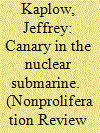

|
|
|
|
|
| Summary/Abstract |
The Treaty on the Non-Proliferation of Nuclear Weapons (NPT) allows states to exempt nuclear material from international safeguards for use in nuclear submarine programs. This material, however, could be diverted for nuclear weapons purposes without the knowledge of inspectors, creating a potentially dangerous loophole in the treaty. This article argues that exercising that loophole today would amount to admitting a nuclear weapon program, making it a particularly poor pathway to a weapon for a potential proliferant. Still, if states like Brazil ultimately exempt nuclear material from safeguards for a nuclear submarine effort, they could set a dangerous precedent that makes it easier for others to use the loophole as a route to a nuclear weapon capability. There are several policy options available to mitigate the damage of such a precedent; most promising is the prospect of a voluntary safeguards arrangement that would allow international inspectors to keep an eye on nuclear material even after it has been dedicated to a naval nuclear propulsion program.
|
|
|
|
|
|
|
|
|
|
|
|
|
|
|
|
| 5 |
ID:
114562
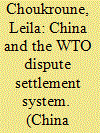

|
|
|
|
|
| Publication |
2012.
|
| Summary/Abstract |
Since its accession to the WTO on 11 December 2001, China has been involved in eight cases as complainant, 23 as respondent, and 89 as a third party. Against all pre-entry predictions, the China-related cases have not overburdened the WTO dispute settlement system, as if all parties were implicitly respecting a latent period before engaging in commercial hostilities. Often portrayed as a "passive rule taker" in the immediate aftermath of its accession, China was not only learning by attentively watching other members' strategies, but also benefiting from the benevolent attitude of its main trading partners, the US and the EU. Moreover, its participation in 89 WTO disputes as third party is not a trivial detail nor is it a sign of passivity, but rather one of cautious preparation that corresponded to the time needed to properly apprehend its new legal tools and all rights thereunder.
While there are many ways of approaching such an already vast body of decisions and related legal and economic literature, this article tries to reflect the uniqueness of the Chinese trade regime and the impact of such a peculiar mix between economic libreralisation and maintenance of the state on other WTO Members in addressing the following questions: the transitional product-specific safeguard measures adopted in reaction to a market disruption caused by Chinese imports, the antidumping and countervailing duties issue, and the restrictions on exportations or importations imposed by China for economic, but also societal and political reasons.
|
|
|
|
|
|
|
|
|
|
|
|
|
|
|
|
| 6 |
ID:
102682
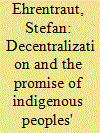

|
|
|
|
|
| Publication |
2011.
|
| Summary/Abstract |
Indigenous peoples' rights, including the right to self-determination, are increasingly codified in international law and policy and disseminated globally by international organizations. These norms mark a profound change in the ideals of citizenship promoted by the international community, away from linguistically and institutionally homogenous citizenship in centralized states to group-differentiated citizenship in decentralized, multi-level and multi-lingual states that use local and regional autonomy for the accommodation of indigenous peoples. Essential to realizing these norms is the devolution of some degree of autonomy to sub-central state units substantially controlled by indigenous communities. Because the transfer of powers to indigenous peoples is crucial to their accommodation, protection and participation in modern states, and because decentralization programs are an important component of reform agendas in most developing countries, it is important to understand how these emerging norms are integrated into real-world decentralization processes.
This article analyzes the application of the World Bank's safeguards policy for indigenous peoples within the institution's support to decentralization reform in Cambodia. The analysis demonstrates that under certain circumstances, the policy not only fails to translate into effective protection but leads to outcomes diametrically opposed to its objectives. In its current design, Bank support to decentralization contributes to the marginalization of indigenous peoples in Cambodia and undermines the institutional, cultural and natural resources upon which their empowerment and participation depends. In environments in which full compliance might be unrealistic to accomplish by individual projects, safeguard obligations lead to a strategy on the part of Bank projects of avoiding geographical and policy areas that are likely to trigger the safeguards policy, in order to reduce projects' vulnerability to non-compliance claims. The article discusses how more effective application of the safeguards policy might be achieved and how strategies for the empowerment of indigenous peoples can more effectively draw on decentralization frameworks.
|
|
|
|
|
|
|
|
|
|
|
|
|
|
|
|
| 7 |
ID:
144286


|
|
|
|
|
| Summary/Abstract |
While nuclear suppliers compete in markets, they simultaneously partner in other fields. This produces a delicate relationship between civilian nuclear programs and nuclear weapon proliferation. This study explores how export competition affects suppliers’ conditions of supply related to nuclear nonproliferation. We investigated three export cases (India, North Korea, and South Korea) and identified four effects that competition has on the conditions of supply related to nonproliferation. First, under highly competitive conditions, suppliers might hesitate to enforce the conditions of supply to avoid negotiation conflicts with recipients. Second, suppliers focus on politically and economically attractive recipients while mostly ignoring unattractive ones, perhaps allowing proliferation problems to fester out of view in marginal states. Third, suppliers can build consensus on the conditions of supply to avoid being the only party experiencing negotiation conflicts. Fourth, suppliers can constrain others from relaxing the conditions of supply to maintain economic benefits and nonproliferation norms. The first two effects accelerate proliferation while the last two promote nonproliferation. Although the extent of these effects can vary with changes in nonproliferation norms, they can contribute to our understanding of the relationship between nonproliferation and civilian nuclear programs.
|
|
|
|
|
|
|
|
|
|
|
|
|
|
|
|
| 8 |
ID:
083839


|
|
|
|
|
| Publication |
2008.
|
| Summary/Abstract |
Export controls and international safeguards are central to ensuring international confidence in the peaceful uses of nuclear materials and technologies and to achieving adequate oversight on the transfer and use of nuclear materials, technology, and equipment required for the development of proliferation-sensitive parts of the nuclear fuel cycle. Although the independent strengths of export controls and international safeguards rely largely on universal adherence, there may be opportunities to exploit the shared strengths of these systems. This article provides background information on the separate evolution of export controls and international safeguards, considers how these two elements of the nonproliferation regime interact, and identifies some possible avenues that could, over time, lead to wholly integrated activities.
|
|
|
|
|
|
|
|
|
|
|
|
|
|
|
|
| 9 |
ID:
153896


|
|
|
|
|
| Summary/Abstract |
Brazil, a developing country with an advanced nuclear program, presents an interesting case for observers of nuclear politics. Brazil is one of a handful of countries that possess uranium-enrichment technology, one of three countries in Latin America that produce nuclear power, and the only country without nuclear weapons to pursue an ambitious nuclear-powered submarine program. Among external views on Brazil's nuclear politics, the perceptions of Argentina and the United States matter most. With Argentina, Brazil shares responsibility for regional security. The two countries’ commitment to a bilateral nuclear safeguards arrangement contributes to a peaceful environment in the region. The United States will continue to set the tone in global nuclear matters and thus its views of Brazil's role in the nuclear field will continue to matter to Brasília, even as Brazil's political and economic crises have thrown the country’s nuclear future into uncertain territory.
|
|
|
|
|
|
|
|
|
|
|
|
|
|
|
|
| 10 |
ID:
083837
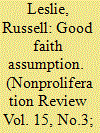

|
|
|
|
|
| Publication |
2008.
|
| Summary/Abstract |
There are a number of competing paradigms on nonproliferation issues, each with their own self-consistent set of axioms that have to be dealt with on their own terms. If these different approaches are not appropriately acknowledged during discussions, they can become a permanent barrier to the resolution of underlying issues. This article identifies some of the key interest groups that are involved in discussions of nuclear nonproliferation issues and seeks to delineate the paradigmatic differences between these groups. These differences in approach can give rise to the perception that one or more of the parties to any discussion are arguing in bad faith. While bad faith may be a cause of at least some of the disputes that arise on nonproliferation issues, assuming bad faith as an explanation for these differences is counterproductive; it prevents any serious discussion of the issues underlying such disputes and obstructs attempts to reach a common understanding
|
|
|
|
|
|
|
|
|
|
|
|
|
|
|
|
| 11 |
ID:
153901
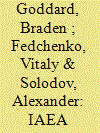

|
|
|
|
|
| Summary/Abstract |
The International Atomic Energy Agency uses a concept of “significant quantity” to establish accounting limits and to determine how much nuclear material can be unaccounted for before the construction of a nuclear device becomes possible. Under the current SQ values, some materials could potentially be under-regulated, while others have disproportionately tight accounting practices, thus interfering with optimal safeguards efficacy. This article compares the SQ values of various materials and reviews the categories adopted by a variety of national regulators to show similarities and differences of approaches. The article concludes by offering possible solutions to increase safeguards efficacy and reduce costs, while acknowledging potential drawbacks. All findings and conclusions are based on open-source publications and publicly available information.
|
|
|
|
|
|
|
|
|
|
|
|
|
|
|
|
| 12 |
ID:
096506
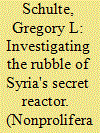

|
|
|
|
|
| Publication |
2010.
|
| Summary/Abstract |
Damascus has severely impeded an investigation by the International Atomic Energy Agency (IAEA) into Syria's construction of a covert nuclear reactor, which was destroyed in a 2007 Israeli air strike. Pressing Damascus to cooperate with the inquiry is necessary to ascertain that there are no other undeclared activities in Syria, to determine the role of North Korea in the construction of the reactor, and to help prevent future clandestine efforts. With Damascus doing its best to avoid the investigation, securing Syrian cooperation will require adept diplomacy backed by the prospect of special inspections and, if necessary, a referral to the UN Security Council. The case of Syria's secret reactor highlights areas in which the IAEA needs buttressing, from the enhanced sharing of information, to reporting that is less political and more forthright. The case also illustrates the downside of politicizing IAEA investigations and supports the new director's apparent intent to return the agency to its core technical tasks.
|
|
|
|
|
|
|
|
|
|
|
|
|
|
|
|
| 13 |
ID:
157822
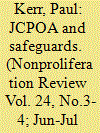

|
|
|
|
|
| Summary/Abstract |
Although the nuclear safeguards established in the 2015 Joint Comprehensive Plan of Action (JCPOA) are explicitly confined to application in Iran, some experts and policy makers have considered whether these supplementary measures could be applied to other states of proliferation concern. While the JCPOA has provided some useful additions to the International Atomic Energy Agency (IAEA) safeguards toolkit, its legacy for the broader IAEA safeguards mission is unclear. To better assess this potential legacy, this article considers the JCPOA in the context of the evolution of safeguards, particularly the developments following the 1991 Gulf War and subsequent changes to safeguards implementation in Iraq. The article then describes the JCPOA’s safeguards in Iran and the potential to apply similar provisions elsewhere.
|
|
|
|
|
|
|
|
|
|
|
|
|
|
|
|
| 14 |
ID:
171179
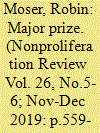

|
|
|
|
|
| Summary/Abstract |
This article focuses on the final years of South Africa’s nuclear-weapon program, particularly on the decision-making process leading up to the signature of the 1968 Treaty on the Non-Proliferation of Nuclear Weapons (NPT) by the South African government in 1991. In August 1988, after two decades of defiance, negotiations between the apartheid government and the NPT depository powers (the United Kingdom, the United States, and the Soviet Union) ensued at the International Atomic Energy Agency (IAEA) in Vienna. Despite South Africa being the only state to give up its indigenously developed nuclear weapons and subsequently join the nonproliferation regime, little is known about how the national position on NPT accession and IAEA safeguards evolved. Research carried out in multiple archives using hitherto untapped primary sources and interviews with key actors from several countries show how domestic and regional political dynamics influenced Pretoria’s position on entering the nonproliferation regime. In the process, the F.W. de Klerk government managed to skillfully exploit international proliferation fears to advance its own agenda, thereby connecting South African NPT accession with that of the neighboring Frontline States coalition of Angola, Mozambique, Tanzania, Zambia, and Zimbabwe.
|
|
|
|
|
|
|
|
|
|
|
|
|
|
|
|
| 15 |
ID:
171177


|
|
|
|
|
| Summary/Abstract |
The International Atomic Energy Agency (IAEA) faces challenges in fulfilling its safeguards mandate as a result of an expanding safeguards burden and a relatively static budget. This dilemma has been exacerbated by the additional burdens of implementing the Joint Comprehensive Plan of Action (JCPOA) in Iran, but would not go away if implementation of the JCPOA were to end. There are three main areas of opportunity for the Agency: (1) budgetary expansion tied to changes in staffing policies, (2) changes in safeguards approaches, and (3) technological innovation. Barriers and limitations are associated with each approach, and advancing any of them will face a difficult political environment in Vienna.
|
|
|
|
|
|
|
|
|
|
|
|
|
|
|
|
| 16 |
ID:
143306


|
|
|
|
|
| Summary/Abstract |
The present international standard allows non-nuclear weapon states (NNWS) to forego safeguards when nuclear material is used in a “non-proscribed military activity,” though no criteria have been established to determine when NNWS can remove naval nuclear material from safeguards. Though at present, only nuclear-armed states possess nuclear submarines, the global nuclear naval landscape may soon change with the advancement of Brazil's fledgling program and the possible precedent it would set for other NNWS. A framework is needed to shore up nuclear security and prevent nuclear material diversion from the nuclear naval sector. Proposed and existing nonproliferation frameworks, including a Fissile Material Cut-off Treaty and commitments through the nuclear security summits, are insufficient to close this loophole. A Naval Use Safeguards Agreement (NUSA), modeled after the Additional Protocol of the International Atomic Energy Agency, would provide a framework to remove the opacity surrounding nuclear material in the naval sector. Designed for NNWS and encouraged as confidence-building measures for nuclear weapon states, NUSA would explicitly outline those stages in the naval nuclear fuel cycle where safeguards are to be applied and in what context. This viewpoint also further provides direction for targeted research and development in technical naval nuclear safeguards solutions.
|
|
|
|
|
|
|
|
|
|
|
|
|
|
|
|
| 17 |
ID:
089068
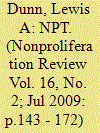

|
|
|
|
|
| Publication |
2009.
|
| Summary/Abstract |
This article assesses the successes and failures of the Treaty on the Non-Proliferation of Nuclear Weapons (NPT) since its creation in 1968 by developing and applying a set of "metrics" to each of the NPT's substantive articles as well as to its withdrawal provisions. In light of this analysis, the article also puts forward some specific proposals for strengthening the NPT and its implementation, with a view to the debate and decisions at the upcoming 2010 NPT Review Conference. A concluding section turns explicitly to the 2010 NPT Review Conference and proposes pursuit of agreement on three NPT Action Plans: one for nonproliferation, one for peaceful uses, and one for nuclear disarmament. Combining vision and practicable steps, these Action Plans would set out a roadmap for action between the 2010 and the 2015 NPT Review Conferences. They could provide a foundation for substantive exchanges-in this case, on progress toward their implementation-during the preparations for the 2015 conference.
|
|
|
|
|
|
|
|
|
|
|
|
|
|
|
|
| 18 |
ID:
176864


|
|
|
|
|
| Summary/Abstract |
The long-term sustainability of nuclear energy requires a closed fuel cycle in which used fuel is reprocessed and recycled. Unlike the PUREX process, which produces a pure plutonium product, pyro-processing produces a depleted uranium ingot and a mixed ingot of depleted uranium and transuranic elements (neptunium, plutonium, americium, and curium) in the ratio 1:1. This seems to suggest that pyro-processing has a lower nuclear proliferation risk compared to PUREX because of the non-availability of a pure Pu product in pyro-processing. In this paper, we study some of the technical challenges in safeguarding a pyro-processing facility with respect to various special nuclear material (SNM) diversion scenarios and propose some possible solutions. We also analyze the misuse of pyro-processing in tandem with a covert PUREX facility. Wide-area environmental sampling and satellite imagery could detect the misuse. Additional strategies recommended are: employment of resident inspectors, establishment of dedicated nuclear safeguards funds, and international sanctions against the misuse of pyro-processing facilities. Results of the study show that suggested technical and administrative measures can make SNM diversion from a pyro-processing facility extremely difficult. We conclude that the use of pyro-processing in place of PUREX in a closed fuel cycle can lower the proliferation risk.
|
|
|
|
|
|
|
|
|
|
|
|
|
|
|
|
| 19 |
ID:
127130


|
|
|
|
|
| Publication |
2013.
|
| Summary/Abstract |
Fusion reactors have the potential to be used for military purposes. This article provides quantitative estimates about weapon-relevant materials produced in future commercial fusion reactors and discusses how suitable such materials are for use in nuclear weapons. Whether states will consider such use in the future will depend on specific regulatory, political, economic, and technical boundary conditions. Based on expert interviews and the political science literature, we identify three of these conditions that could determine whether fusion power will have a military dimension in the second half of this century: first, the technological trajectory of global energy policies; second, the management of a peaceful power transition between rising and declining powers; and third, the overall acceptance of the nuclear normative order. Finally, the article discusses a few regulatory options that could be implemented by the time fusion reactors reach technological maturity and become commercially available; such research on fusion reactor safeguards should start as early as possible and accompany the current research on experimental fusion reactors.
|
|
|
|
|
|
|
|
|
|
|
|
|
|
|
|
| 20 |
ID:
075784


|
|
|
|
|
| Publication |
2006.
|
| Summary/Abstract |
This research report explains why safeguards on uranium-ore mines are a theoretically interesting way of dealing with clandestine enrichment facilities, complementing several nonproliferation schemes. A description of mining operations explains how safeguarding mines could fulfill two nonproliferation objectives: ensuring the non-diversion of uranium from mines, and establishing a certified inventory of uranium for use in follow-on material accounting. However, this report also finds that it is essentially impossible to detect undeclared mining, and that this fatal flaw eliminates the ability of safeguards on mines to be useful in addressing the clandestine enrichment problem.
|
|
|
|
|
|
|
|
|
|
|
|
|
|
|
|
|
|
|
|
|